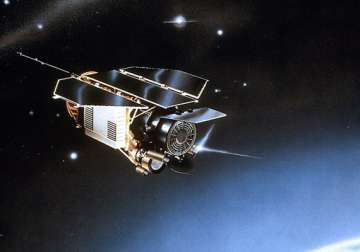Beijing Was 7 Minutes From Disaster When 2.5 Ton German Satellite Fell On Earth
London, Feb 1: Seven minutes saved huge areas of Beijing from destruction last year when a 2.5 ton satellite hurtled towards earth, it has been revealed.The Chinese capital was directly in the flight path of

London, Feb 1: Seven minutes saved huge areas of Beijing from destruction last year when a 2.5 ton satellite hurtled towards earth, it has been revealed.
The Chinese capital was directly in the flight path of Germany's research satellite Rosat when it plunged into the Bay of Bengal last October, two decades after it's launch, reports Daily Mail.
The consequences of chunks of the 2.5 ton satellite falling into the city would have been catastrophic; huge craters, shattered fuel lines, explosions, wrecked buildings and untold human casualties in a metropolis of 20 million people.
Parts of the satellite would likely have torn deep craters into the city, may have destroyed buildings and almost certainly would have resulted in human casualties.
It was ‘perilously close,' to hitting Beijing at nearly 300 mph, said the European Space Agency.
The satellite would have re-entered the atmosphere at a much higher speed, but the friction of the atmosphere slows satellites as they descend - burning them up and tearing them to pieces.
‘Beijing lay directly in the path of its last orbit,' said Manfred Warhaut of the European Space Operations Centre in Darmstadt, Germany.
But scientists had no way of controlling it once it went out of business miles above the earth.
‘Our calculations showed that, if Rosat had crashed to the ground just seven to 10 minutes later, it would have hit Beijing,' says Klinkrad.
An impact ‘was very much within the realm of possibility,' added Heiner Klinkrad, head of the ESA's Space Debris team.
Rosat weighed 2.5 tons. Normally, some 20 to 40 per cent of a satellite reaches the Earth's surface when it falls out of orbit.
‘But with Rosat, we knew it would be around 60 percent because it was made out of particularly heavy and durable parts,' said Klinkrad.
Rosat was one of the closest-run things yet involving ‘space junk' returning to earth.
Rosat went aloft on June 1, 1990 when launched into orbit from Cape Canaveral on a quest to search for the sources of X-ray radiation.
A mission intended to last just 18 months, the satellite remained transmitting data about black holes and far off galaxies for nine years.
It began falling towards earth after a further redundant 11 years on October 22 last year.
Still spokesperson Bernard Von Weyhe is keen to caution that ten minutes in space time is a long time.
The satellite travels so fast that 'if it hit one minute earlier it would have been in Siberia and one minute later in the Pacific Ocean,' Von Weyhe said.
Next on the worry list is the NASA Rossi X-ray Timing Explorer which will present a 1-in-1,000 chance of harming someone when it makes an uncontrolled fall from Earth orbit some time after 2014 - a level ten times riskier than NASA now requires for re-entering spacecraft, according to an agency spokesman.
The forecast for the satellite's re-entry calls for a return between 2014 and 2023. Fluctuations in solar activity cause the atmosphere to expand and contract, making it difficult to accurately predict when uncontrolled satellites will re-enter the earth's atmosphere from deep space.
The satellite, launched in December 1995, was designed before NASA issued standards for public safety from re-entering spacecraft. NASA satellites must now have a probability of striking a person of less than 1-in-10,000.
‘This satellite was launched four months before the first NASA standard on orbital debris mitigation and re-entry risk management was issued,' said Beth Dickey, a spokesperson at NASA Headquarters in Washington.
‘As such, it was not subject to the re-entry risk guideline, since it had already been built.'
The Rossi X-ray Timing Explorer is currently circling 294 miles above Earth. When the 7,000-pound satellite falls from orbit it could threaten areas lying under its equatorial flight path.
Spacewatchers believe it is only a matter of time before such space junk does get through to earth and cause massive destruction.
An EU funded project currently underway in Germany to try to construct a defence shield to protect earth from wayward asteroids will also seek to defend us from manmade spacecraft returning homewards.